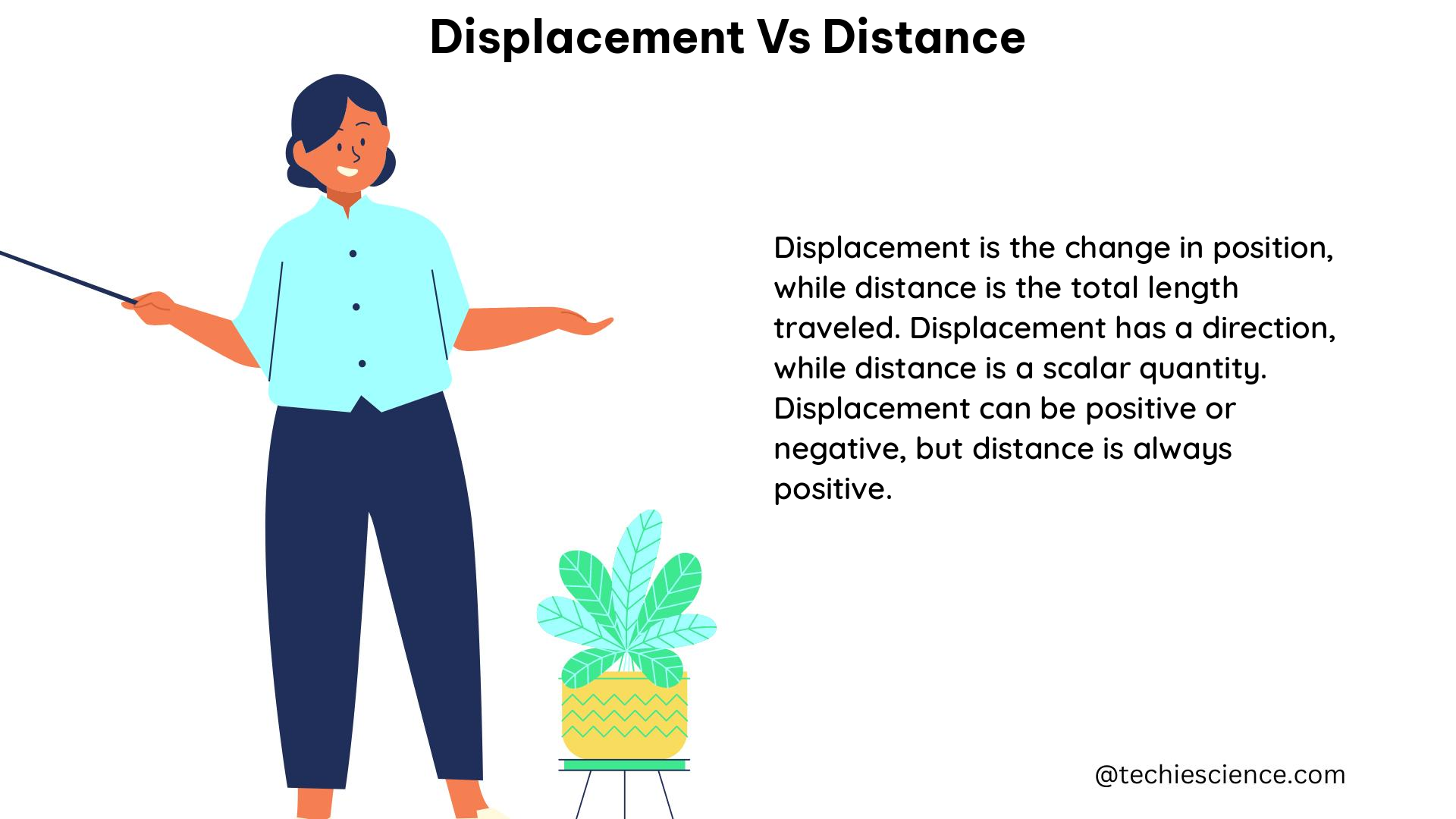Displacement and distance are two fundamental concepts in physics that describe the movement of objects. While they are related, they have distinct properties and applications. This comprehensive guide will delve into the technical details, formulas, examples, and numerical problems to help science students understand the nuances between displacement and distance.
Understanding Displacement
Displacement is a vector quantity that measures the change in an object’s position from its initial location to its final location. It has both magnitude (length) and direction, which can be positive, negative, or zero, depending on the direction of the motion.
The formula for calculating displacement is:
Δx = xf – x0
Where:
– Δx is the displacement
– xf is the final position
– x0 is the initial position
Properties of Displacement
- Directionality: Displacement is a vector quantity, meaning it has both magnitude and direction. The direction of the displacement can be positive, negative, or zero, depending on the object’s movement.
- Straight-line Distance: The magnitude of the displacement is the straight-line distance between the initial and final positions, regardless of the path taken.
- Relative Motion: Displacement is relative to the frame of reference. The same motion can result in different displacements depending on the chosen frame of reference.
- Additive Property: Displacements can be added or subtracted vectorially to find the net displacement.
Examples of Displacement
- A car travels 50 miles east and then 50 miles west. The total distance traveled is 100 miles, but the displacement is 0 miles because the car ends up in the same place it started.
- A person walks 10 meters north and then 10 meters south. The total distance traveled is 20 meters, but the displacement is 0 meters because the person ends up in the same place they started.
- A satellite orbits the Earth in a circular path. The distance traveled is the circumference of the circle, but the displacement is 0 because the satellite returns to its initial position.
Understanding Distance

Distance is a scalar quantity that measures the total length of the path an object travels, regardless of its starting or ending position. It is always positive or zero, and it cannot be negative.
Properties of Distance
- Scalar Quantity: Distance is a scalar quantity, meaning it has only magnitude and no direction.
- Absolute Value: Distance is always positive or zero, and it cannot be negative.
- Path-dependent: Distance depends on the path taken by the object, not just the initial and final positions.
- Additive Property: Distances can be added together to find the total distance traveled.
Examples of Distance
- A car travels 100 miles along a straight highway from point A to point B. The distance traveled is 100 miles, and the displacement is also 100 miles in the direction from point A to point B.
- A car travels 100 miles in a circle, returning to its starting point. The distance traveled is 100 miles, but the displacement is zero because the car ends up in the same place it started.
- A person walks 10 meters north and then 10 meters south. The total distance traveled is 20 meters, and the displacement is 0 meters because the person ends up in the same place they started.
Numerical Problems and Calculations
- A car travels 50 miles east, then 30 miles north, and finally 20 miles west. Calculate the total distance traveled and the displacement.
Solution:
– Total distance traveled = 50 miles + 30 miles + 20 miles = 100 miles
– Displacement = √((50 miles)^2 + (30 miles)^2 + (-20 miles)^2) = 60 miles in the northeast direction
- A person walks 10 meters north, then 15 meters east, and finally 8 meters south. Calculate the total distance traveled and the displacement.
Solution:
– Total distance traveled = 10 meters + 15 meters + 8 meters = 33 meters
– Displacement = √((10 meters)^2 + (15 meters)^2 + (-8 meters)^2) = 19 meters in the northeast direction
- A satellite orbits the Earth in a circular path with a radius of 6,371 kilometers. Calculate the total distance traveled and the displacement after one complete orbit.
Solution:
– Total distance traveled = 2π × 6,371 kilometers = 40,030 kilometers
– Displacement = 0 kilometers, as the satellite returns to its initial position
Graphical Representation
The difference between displacement and distance can be visualized using a graph. Consider the following example:

In this graph, the blue line represents the distance traveled, while the red line represents the displacement. The distance traveled is the total length of the path, while the displacement is the straight-line distance between the initial and final positions.
Practical Applications
The concepts of displacement and distance have numerous practical applications in various fields of science and engineering, including:
- Kinematics: Displacement and distance are fundamental quantities in the study of motion, used to describe the position, velocity, and acceleration of objects.
- Navigation: Displacement is used in navigation systems to determine the position and direction of a moving object, such as a vehicle or a spacecraft.
- Surveying and Mapping: Distance is used in surveying and mapping to measure the dimensions of land, buildings, and other structures.
- Robotics: Displacement is used in robotics to control the movement and positioning of robotic systems.
- Sports and Exercise: Distance is used to measure the performance of athletes, such as the distance covered in a race or the length of a jump.
Conclusion
Displacement and distance are two distinct concepts in physics, each with its own unique properties and applications. Understanding the differences between these two quantities is crucial for science students to accurately describe and analyze the motion of objects. By mastering the technical details, formulas, examples, and numerical problems presented in this comprehensive guide, students will be well-equipped to apply these concepts in their studies and future endeavors.
References
- Study.com, Distance vs Displacement in Physics | Differences & Example – Lesson, https://study.com/academy/lesson/distance-and-displacement-in-physics-definition-and-examples.html
- MIT Admissions, Distance and Displacement, https://mitadmissions.org/blogs/entry/distance-and-displacement/
- GeeksforGeeks, Distance and Displacement – Definition, Formulas, and Examples, https://www.geeksforgeeks.org/distance-and-displacement/
- OpenStax, 2.1 Relative Motion, Distance, and Displacement – Physics, https://openstax.org/books/physics/pages/2-1-relative-motion-distance-and-displacement

I am Raghavi Acharya, I have completed my post-graduation in physics with a specialization in the field of condensed matter physics. I have always considered Physics to be a captivating area of study and I enjoy exploring the various fields of this subject. In my free time, I engage myself in digital art. My articles are aimed towards delivering the concepts of physics in a very simplified manner to the readers.